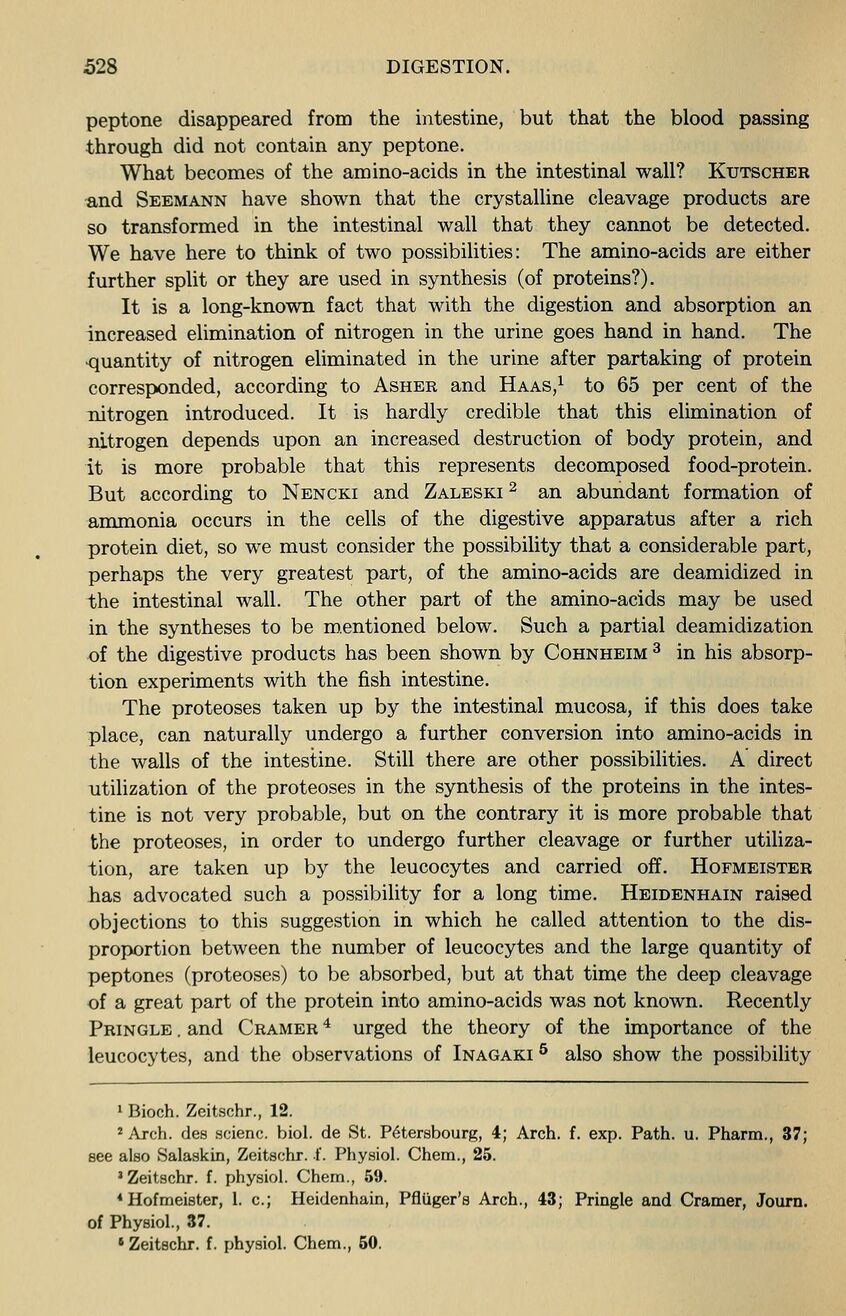
Full resolution (JPEG) - On this page / på denna sida - VIII. Digestion - VI. Absorption

<< prev. page << föreg. sida << >> nästa sida >> next page >>
Below is the raw OCR text
from the above scanned image.
Do you see an error? Proofread the page now!
Här nedan syns maskintolkade texten från faksimilbilden ovan.
Ser du något fel? Korrekturläs sidan nu!
This page has never been proofread. / Denna sida har aldrig korrekturlästs.
528 DIGESTION.
peptone disappeared from the intestine, but that the blood passing
through did not contain any peptone.
What becomes of the amino-acids in the intestinal wall? Ktjtscher
and Seemann have shown that the crystalline cleavage products are
so transformed in the intestinal wall that they cannot be detected.
We have here to think of two possibilities: The amino-acids are either
further split or they are used in synthesis (of proteins?).
It is a long-known fact that with the digestion and absorption an
increased elimination of nitrogen in the urine goes hand in hand. The
•quantity of nitrogen eliminated in the urine after partaking of protein
corresponded, according to Asher and Haas,1
to 65 per cent of the
nitrogen introduced. It is hardly credible that this elimination of
nitrogen depends upon an increased destruction of body protein, and
it is more probable that this represents decomposed food-protein.
But according to Nencki and Zaleski 2
an abundant formation of
ammonia occurs in the cells of the digestive apparatus after a rich
protein diet, so we must consider the possibility that a considerable part,
perhaps the very greatest part, of the amino-acids are deamidized in
the intestinal wall. The other part of the amino-acids may be used
in the syntheses to be mentioned below. Such a partial deamidization
of the digestive products has been shown by Cohnheim 3
in his absorp-
tion experiments with the fish intestine.
The proteoses taken up by the intestinal mucosa, if this does take
place, can naturally undergo a further conversion into amino-acids in
the walls of the intestine. Still there are other possibilities. A direct
utilization of the proteoses in the synthesis of the proteins in the intes-
tine is not very probable, but on the contrary it is more probable that
the proteoses, in order to undergo further cleavage or further utiliza-
tion, are taken up by the leucocytes and carried off. Hofmeister
has advocated such a possibility for a long time. Heidenhain raised
objections to this suggestion in which he called attention to the dis-
proportion between the number of leucocytes and the large quantity of
peptones (proteoses) to be absorbed, but at that time the deep cleavage
of a great part of the protein into amino-acids was not known. Recently
Pringle . and Cramer 4
urged the theory of the importance of the
leucocytes, and the observations of Inagaki 5 also show the possibility
1
Bioch. Zeitschr., 12.
2
Arch, des scienc. biol. de St. P6tersbourg, 4; Arch. f. exp. Path. u. Pharm., 37;
see also Salaskin, Zeitschr. f. Physiol. Chem., 25.
1
Zeitschr. f. physiol. Chem., 59.
Hofmeister, 1. c; Heidenhain, Pfluger’s Arch., 43; Pringle and Cramer, Journ.
of Physiol., 37.
6
Zeitschr. f. physiol. Chem., 50.
<< prev. page << föreg. sida << >> nästa sida >> next page >>